
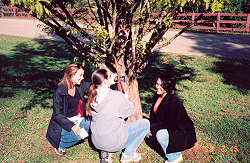 |
Article by Brandi Evans, Ashley Upton, and Carrie Giles Images by Thomas H. Wilson |
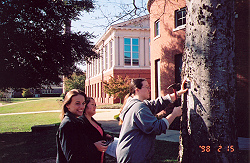 |
The main objective of this applied botany course was the full identification of trees along with selected ferns and other native plants. Forest Trees: A Guide to the Southeastern and Mid-Atlantic Regions of the United States by Lisa J. Samuelson, Auburn Community Dendrologist, was the class reference book. |
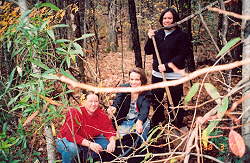
|
 |
| Field work began with a tour of the Judson College campus. The campus has great tree diversity. Dr. Wilson is responsible for buying, planting, and maintaining many of the trees on Judson's campus. The college is the home of five Alabama State Champion Trees! |
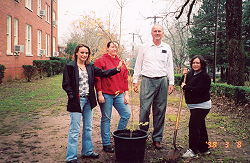 |
| These trees are: Chinese elm (Ulmus parufolia), English oak (Quercus robur), Japanese evergreen oak (Quercus acuta), Japanese flowering cherry (Prunus serrulata), and Leyland cypress (Cupressocyparis leylandii).Dr. Wilson is responsible for nominating each of these trees for the program. Another factor that makes our campus trees so unique is many of the trees stay green year-round. The evergreen trees on campus are: China fir (Cunninghamia lanceolata), Deodar cedar (Cedrus deodara), Eastern redcedar (Juniperus virginiana L.), Japanese evergreen oak, Leyland cypress, and Live Oak (Quercus virginiana). | |
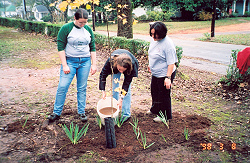 |
The class then went out into the surrounding areas in search of adventure. We first visited the Episcopal Church Cemetery of Marion, Alabama. Here, we had our first test of our knowledge. |
| Dr. Wilson challenged us to use what we had learned to identify the Judson campus trees and identify the same species of tree but in a different habitat. We quickly learned the difficulty of tree identification. | |
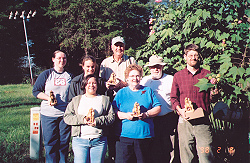
|
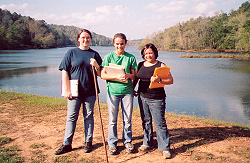 |
| The class then toured the local community. One special place we visited was Dr. Wilson's home. Dr. and Mrs. Wilson have spent years developing their property into a botanical wonderland. |
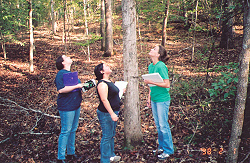 |
| We identified the Blackgum (Nyssa sylvatica), Japanese persimmon (Diospyros kaki), Pawpaw (Asimina triloba), and the Pondcypress (Taxodium distichum var. imbricarium) on the Wilson property. | |
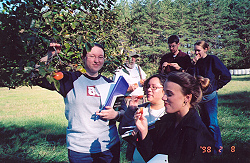 |
With our new-found confidence, we moved into the wetlands of Perry Lakes Park and studied trees adapted to the swamp. |
| The swamp-habitat trees are the Bald cypress (Taxodium distichum var. distichum), Blackgum, Pond Cypress, Swamp chestnut oak (Quercus michauxii), Swamp tupelo (Nyssa biflora), and Water tupelo (Nyssa aquatica L.). The rare Red hickory (Carya ovalis) and the Slippery elm (Ulmus rubra) are State Champion trees of Perry Lakes Park. Both were nominated by Dr. Wilson. | |
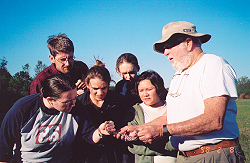 |
The class visited the Paul Grist State Park north of Selma. Dominant trees of the park were: American Beech (Fagus grandifolia), Hornbeam (Carpinus caroliniana), and Sourwood (Oxydendrum arboreum). The main focus of this park was the Chestnut oak (Quercus prinus L.) |
| We took our final field trip to a Treasure Forest in Brent, Alabama. The class met its biggest challenge! Dan James, Chairman of RC & D Committee for Bibb County, tested us on all our knowledge of the entire semester. We identified some trees correctly, we misidentified some trees (new terrain and new look), and we learned some new species as well. |
 |
| Mr. James introduced us to the Bur oak (Quercus macrocarpa), Hercules'-club (Zanthoxylum clava-herculis L.), Honeylocust (Gleditsia triacanthos L.), Sawtooth oak (Quercus acutissima) and Witch-hazel (Hamamelis virginiana). It was interesting to see the effects that habitat has on trees. | |
| At the conclusion of our tour, Mr. James showed us his favorite pastime. He likes to be involved in wood-identifying contests. In this contest, a person must be able to identify samples of unlabeled wood by sight, smell, and/or taste. Mr. James has competed internationally, and he is very good at what he does! At the conclusion of this trip, Mr. and Mrs. James gave each member of the class an Olive wood carving of nativity scenes from Bethlehem. | |
| The Class wanted to plant a tree as a lasting memory of this course. We chose to add a native Florida Maple (Acer barbatum) to the Judson treescape. The class transplanted the maple from nature to the Layfette Street-side of the WMU dormitory. We will treasure our memories and knowledge from this course. | |